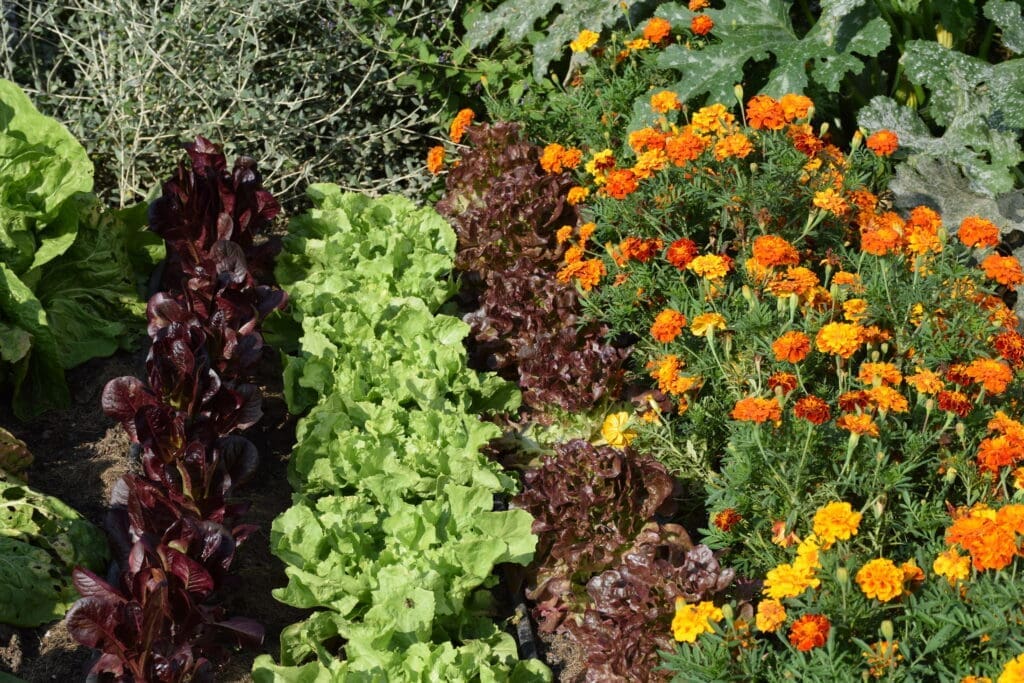If you are new to gardening and want your plants to thrive, then companion planting is something you need to know about. Companion planting is a centuries-old gardening practice that involves sowing compatible plants together to help each other grow better. While companion seeding may sound simple, there’s a lot of science behind it. This blog post explains the in-depth basics of companion planting and how it works. We will also dive into the benefits of companion plants in deterring pests and diseases, attracting beneficial insects and birds, and enhancing crop productivity. Lastly, we will provide practical tips on implementing companion seeding in your English garden, with examples of successful plant combinations for common vegetables.
Understanding Companion Planting
Companion planting in your garden promotes biodiversity and offers a range of benefits. Seeding certain crops together can deter pests and diseases, maximising space utilisation. This traditional gardening practice has a rich history rooted in the idea that certain plants benefit each other. Companion planting involves strategically pairing two or more crop species to achieve higher yields and natural pest control. It’s not just about sowing any random combination; it’s about understanding which plants work well together. For example, seeding tall plants like runner beans beside squashes can provide shade and support. Additionally, the strong scent of plants like fennel and mint can repel white flies and attract ladybirds, which feed on aphids. With companion sowing, you can create a harmonious environment in your garden that benefits your plants and enhances overall growth.
The Concept and History of Companion Planting
For centuries, gardeners worldwide have practised cross-plantation. This technique reduces and improves flavours and allows for the simultaneous planting of various varieties. Rotation planting has made its mark back to ancient civilisations like the Romans and Egyptians, who incorporated this method into their agricultural practices. Native Americans also utilised cross-plantation techniques to enhance their crop yields. This traditional wisdom has contributed to the development of mixed cropping techniques. The underlying formula behind mix cropping is that certain plants can have natural affinities with each other, creating a beneficial relationship in the garden. By understanding the concept and history of cross plantation, you can harness the power of plants working together harmoniously.
Read more on planting cell walls.
The Science Behind Mix Planting
Companion planting is not just about aesthetics or tradition; it has roots even in science. One of the benefits of crop rotation is its ability to attract beneficial insects and birds to the garden, such as ladybirds, which can help control pests like whiteflies. Additionally, some companion plants emit chemicals that repel pests and protect neighbouring crops, creating a natural defence system. Furthermore, companion plants can improve soil fertility by fixing nitrogen or accumulating nutrients, benefiting plants like squash, leeks, and runner beans. A well-versed plant community created through crop mixing supports a healthy ecosystem, promoting biodiversity and ecological balance in your garden. Research has also shown that certain plant combinations in crop rotation can enhance crop productivity, making it a valuable technique for gardeners.
The Role of Companion Plants in Deterring Pests and Diseases
Certain companion plants, such as marigolds and nasturtiums, can repel common garden pests. In addition, plants like chives and garlic have natural insect-repellent properties, effectively deterring pests. Apart from repelling problems, companion plants can create a physical barrier that hinders pests’ access to vulnerable crops. Moreover, specific combinations of plants can confuse pests, disrupting their ability to locate their preferred host plants. This strategic use of companion plants not only deters pests but also helps reduce the reliance on chemical pesticides in your beautiful garden. You can rejuvenate a healthier, more resilient garden ecosystem by incorporating cross-plantation techniques into your gardening practices.
Know more about types of rare biomes.
Attracting Beneficial Insects and Birds
Attracting beneficial insects and birds is an essential aspect of companion planting. Certain companion plants, such as thyme and sage, emit fragrances that attract beneficial insects like lacewings and hoverflies. Additionally, flowers like calendula and borage are a magnet for pollinators like bees and butterflies. Companion plants will maintain a balanced ecosystem throughout your garden or backyard farm by providing food and habitat. Some companion plants, such as parsley and dill, even serve as host plants for beneficial insects during their larval stages. Creating diverse plant communities through mixed plantations ensures the attraction of a wide range of beneficial insects and birds, contributing to a thriving garden environment.
How Does Mix Planting Affect Crop Productivity?
Companion planting positively impacts crop productivity in several ways. It improves pollination, provides shade and support for climbing crops, suppresses weeds, conserves soil moisture, reduces the spread of diseases, and enhances nutrient uptake and soil structure. These factors contribute to healthier and more productive crops.
All around the year, the winner’s seeds
The Effect of Mix Rotation Planting on Space Utilization
Interplanting compatible crops optimises garden space, ensuring every inch is in use. By strategically planting different crops together, gardeners can make the most of limited space. Vertical gardening techniques, like growing pole beans with corn, allow for efficiently utilising vertical space. In this way, plants that naturally grow tall can support climbing crops, maximising both horizontal and vertical garden space. Another method to optimise space is succession planting, allowing multiple crops to multiply in the same area throughout the growing season. Additionally, planting taller plants with lower-growing crops creates shade, protecting against excessive heat and improving overall space efficiency. It offers a practical solution for utilising space effectively, especially in small gardens or containers.
What Should You Plant Cucumber, Radish, Cabbage, Courgettes, Broccoli?
When it comes to successful companion planting, several plant combinations work wonders. For instance, pairing tomatoes with basil improves both crops’ flavour and helps in natural pest control. Another great variety is growing cucumbers with radishes to deter pests like cucumber beetles. Additionally, planting beans with carrots enhances nitrogen fixation and soil fertility.
Plant Combinations to Avoid in Companion Planting UK
Planting onions and beans together is not recommended, as they can inhibit each other’s growth. Similarly, tomatoes and potatoes are never together to reduce the risk of disease transmission. Cabbage and other brassicas should not be planted near strawberries, as they can compete for space and nutrients. It’s also advisable to avoid growing thirsty shrubs next to drought-tolerant ones, as this can lead to uneven water distribution.
Additionally, cucumbers and sage don’t grow together, as sage can inhibit the growth of cucumbers. Finally, it’s best to keep asparagus away from alliums like onions and garlic, as they can stunt its growth. Remember these combinations to ensure a successful mixed crop garden.
Implementing Squash, Leeks, Chard, Marigold, Chives Together
Maximise your English garden’s potential by implementing cross-rotation techniques. This method involves growing two or more greens to nurture your desired crops. Not only does mixed cropping create a harmonious and balanced ecosystem, but it also enhances the health and productivity of your crops. One of the key benefits is the natural deterrence of pests and attraction of beneficial insects. For example, intercropping squash with fennel can repel whiteflies and attract ladybirds.
Additionally, planting tall greens like runner beans alongside raspberries can provide support and shade. Sowing leeks near parsnips can deter pests like black flies. By incorporating crop rotation in your English garden, you can maximise your space and enjoy a thriving a diverse ecosystem.
Examples of Successful Companion Plants for Tomatoes
Pairing tomatoes with basil not only enhances the flavour of the tomatoes but also acts as a deterrent for pests like whiteflies. For cucumbers, planting marigolds alongside them serves two purposes – repelling beetles and providing much-needed shade. Another successful combination is growing chives near carrots, which helps deter carrot root flies. To confuse and deter pests, interplanting radishes with spinach is effective.
Additionally, combining peas with lettuce maximises space and enhances soil fertility. These examples showcase the benefits of companion planting, where certain greens act as magnets for beneficial insects like ladybirds while others, like fennel or tall greens with a strong scent, help deter pests. Sowing runner beans close to raspberries not only saves space but also provides support for the beans.
Similarly, planting parsnips alongside mint or lavender can help repel aphids. Kale is also known to benefit from being planted near fruit trees. At the same time, French marigolds and French beans make excellent companions for courgettes. Other successful combinations include planting coriander near cauliflower to attract hoverflies and growing broad beans alongside yarrow to attract predatory wasps that control pests like blackflies. In the UK, sweetcorn grows best with peas and runner beans, forming the well-known “Three Sisters” trio. It offers a natural and sustainable approach to gardening, creating a harmonious and balanced ecosystem in your English garden.
Different ways to identify plants
Why is Companion Planting especially significant in gardening?
English gardens face challenges like pests & limited space. Companion planting promotes a healthy ecosystem, reducing the need for synthetic pesticides & fostering natural pest control. It also provides shade & support for delicate flowers, reflecting the rich tradition of intermingling plant species in English gardens.
Details in brief about Plantae
Conclusion
Companion planting is an age-old technique that brings harmony to your English garden. By strategically pairing plants, you can create a balanced ecosystem that supports growth, deters pests, and enhances productivity. Understanding the concept and history of companion planting and its science will help you make informed choices when planning your garden. By following our practical guide and implementing cross-rotation cropping in your English garden, you can enjoy the benefits of healthier plants, increased yields, and a more sustainable and beautiful garden. Remember to share your newfound knowledge and the beauty of your English garden on social media to share with your near and dear friends and family.



